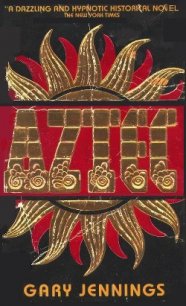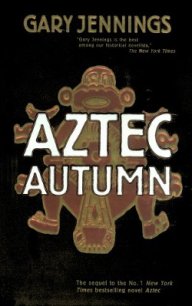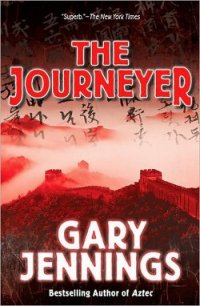Aztec Blood - Jennings Gary (книги онлайн бесплатно серия .txt) 📗
Children were instructed to keep their teeth clean to avoid decay; salt and powered charcoal were used with a wooden instrument to clean teeth.
I saw an amazing example of Aztec tooth remedies in a village where another traveling healer had stopped at the same time we did. This healer's specialty was removing painful teeth—painlessly. He applied a substance to the teeth that instantly deadened the tooth. Within hours, the tooth had fallen out.
I asked the Healer what the man had applied that worked so well.
"The venom of a rattlesnake," he said.
The Healer told me not all the products of plants were used to heal. Veintiunilla, the "little twenty-one," caused death in exactly twenty-one days. Persons given the plant developed an insatiable thirst for potent drinks like pulque and cactus wine, and drank the intoxicating beverages until they died.
"Evil Aztec whores tricked men into drinking macacotal, the steeping from a snake. Ayyo, these men engage in ahuilnema with six or seven women, one after another, and moments later are ready to have ahuilnema with even more women. This goes on and on, with the man unable to control his urge, giving anything he owns to the whores, until the life is gone from him and his flesh hangs from his bones."
To have power to satisfy so many women. Muy hombre! What a way to die, eh, amigos?
Another indio aphrodisiac was the "witches rose." Medicine women used magic words to make roses open before their season. These were sold to men for a wicked purpose: the seduction of women. The rose was hidden under the woman's pillow. When she inhaled the scent, she became intoxicated with love for the person who put the rose there and called his name.
I asked him about the drugs that robbed one of their mind. His expression never changed, but when he was amused by something a glint came to his eye and he would emit a quiet, birdlike chuckle. He did so as he told me about yoyotli, the dust that made one so happy and pliable that you danced gaily to the sacrificial block where the priest was waiting with an obsidian knife to cut your heart out.
"Flower weavers are the sorcerers who bring our minds into contact with the gods," the Healer said. Peyotl, from the buds of cacti that grow only in the Place of the Dead, the northern deserts; and brown seeds from ololiuqui, a plant that climbs and clings to other plants, were used to "take people to the gods," which I understood to mean that the person entered a dreamlike state. From the babbling uttered and visions the person experienced, a healer could determine the person's malady.
Teunanacatl, a bitter black mushroom, was called the "flesh of the gods." Occasionally served with honey at feasts, it also took one to the gods, but the hallucinations were less than those created by peyotl. "Some people laugh hysterically, others image they are being chased by snakes or that their bellies are full of worms eating them alive. Others fly with the gods."
A plant that could be smoked was called coyote weed by the Healer. "It makes the smoker feel calm and soothes deep pains." A small smile on his face hinted that some of the tobacco he smoked was of the coyote weed variety.
The most powerful substance was teopatli, the divine ointment. The Healer spoke of it with a tone of awe. To the seeds of certain plants "are added the burnt ashes of spiders, scorpions, centipedes, and other noxious insects, petum to make the flesh painless, and ololiuqui to lift the spirits." When applied to the skin, it made the person invincible, as if an invisible shield was held in front of him. "The greatest warriors of the Aztec were the Jaguar Knights and Eagle Knights; it is said that the weapons of their enemies could not cut them when they had the teopatli ointment applied to their skin."
As the months passed by and we went from one small village to another, I never encountered another rider searching for me. Soon enough of the fear was gone for me to stop puffing up my nose. Because the sun darkened my skin so well, I needed little dye. But for safety's sake the Healer gave me a "sore" to wear on my cheek, a small, black piece of bark held on with sap.
We stayed away from the larger villages and towns while I learned how to think and act like an indio.
Even more than the Spanish, the indios were ruled by superstition and the whim of their gods. Nothing they did or experienced, from the sun overhead and ground beneath their feet, giving birth or to going to the marketplace to sell ears of maize, went without having some spiritual power involved. Sickness came mostly from evil spirits, bad aires, that one breathed in or was touched by. And the cure was to remove the spirits with the magic and herbs of a healer.
The Spanish priests battled the indio superstitions, trying to replace them with Christian rites. Most of the indio customs I found to be harmless or, in the case of herbal medical remedies, to be extremely beneficial. Occasionally I would be shocked.
In our travels to places little visited by outsiders, we came to a village where an old woman had been stoned to death just before our arrival. Her body, with bloodied stones lying about, was still on the ground when we walked in leading the donkey.
I asked the Healer what great crime the old woman had committed.
"She died not for her sins, but the sins of all the villagers. The oldest woman in the village is chosen each year to hear the confessions of all the people in the village. She is then stoned to death to win atonement for the entire village."
?Ayya ouiya!
The gods were as involved in death as they were in life. Just as there was a Christian world of death, the Aztecs had their places where dead spirits resided, both an underworld and a heavenly paradise. Where you went, to the underworld or the celestial heaven, what happened to your soul, depended not upon conduct during life but on how you died.
The House of the Sun was a celestial paradise to the east of the Aztec world. Warriors killed in battle, people who were sacrificed, and women who had died in childbirth shared the honor of residing in this wondrous place after death. The house of the sun was filled with beautiful gardens, perfect weather, and the finest foods. It was the Garden of Eden, the Garden of Allah, paradise.
Warriors who dwelled there passed their time in bloodless battles. But each morning they assembled as a vast army on a great open plain that stretched almost endlessly to the horizon. They were waiting for the sun to rise in the East. When the first glow of light slipped above the horizon, the warriors greeted it by clashing their spears against their shields; then they escorted the sun on its journey across the sky.
After four years, the warriors, sacrifice victims, and women who'd died in childbirth returned to earth as hummingbirds.
Most people, those who succumbed to disease, accidents, and the maladies of old age, went to the Dark Place, the place of the dead, Mictlan.
This underworld, far to the north of the Aztec world, was a place of scorching deserts and winds that can freeze a person in place. The lord of Mictlan was Mictlantecuhtli, a god who wore a skull mask and a cloak of human bones. To reach Mictlan the soul had to journey through eight hells before arriving at the ninth hell, where Mictlantecuhtli and his goddess queen live.
Each of the journeys had the type of dangers Odysseus experienced and the ghoulish horrors of Dante's infernal. The dead must first cross a wide and swift river. A red or yellow dog was needed for this task. After forging the river, they had to pass between two mountains which were clashing together. The tasks became more and more difficult—a mountain of razor-sharp obsidian to be climbed, a region of icy winds that could sear flesh from the bone; places where banners battered wayfarers, where arrows pierced the unwary, and savage beasts ripped open chests to eat human hearts. In the eighth realm, the dead had to climb narrow ledges of cliffs.




